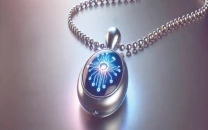Can contact lenses damage your eyes?
Eye doctors say contact lenses may be the most dangerous invention for eye care.

Just like most people who wear contact lenses, Maheen, a mother of two, developed an eye infection after she wore her contacts at a party for about eight hours. Little did she know that things were going to take a turn for the worse.
“I did not take it seriously first,” says Maheen. “My doctor told me it’s a bacterial infection and I used medicines for two-months but to no avail. By the time I went to the fifth eye doctor, my eye was worse, with a greyish white spot in my cornea. That’s when doctors told me that I have lost my eye permanently,” she says.
Fortunately, one doctor gave her a ray of hope when he said there may be a bleak chance that her eye could be saved, but said that she had contracted a fungal keratitis infection, a painful infection of the cornea that can lead to blindness if not treated. Maheen went on an intensive seven-month treatment which involved putting eyedrops every two hours. “The medicine was formulated, so I had to go every third day to the Aga Khan University Hospital to buy it. “I could not go near the stove or look after my two girls,” she says, adding that since the infection had distorted her eye, she was reluctant to meet people.
For this reason, if an ophthalmologist were to define the most dangerous invention for eye care, he would simply say contact lenses, says Dr Jamal Mughal, a consultant eye surgeon. “It is an extremely misused medical device,” he says, adding that people are now using contacts cosmetically instead of as a necessity. The sale of disposable contact lenses has also increased their accessibility to a greater population, with contacts being sold at prices that range from Rs150 to Rs4,000.
Dr Qazi Wasiq, the medical director of Pakistan Eyebank Society Hospital, says that the biggest malpractice is that opticians are now prescribing contacts to people instead of ophthalmologists. “A contact lense is a medical device that is prescribed on certain indications or for very high power vision weaknesses only.”
The perils
Dr Wasiq says that the indiscriminate use of contact lenses can harm the eye, causing problems such as corneal ulcers, corneal abyss, corneal opacity or corneal blindness. If there is an infection on the axis, it may leave a scar even if it heals. If that scar is on the side, vision will not be affected but if it is in the central cornea, vision will be harmed. Two to five per cent of contact lens users face any one of the above mentioned problems.
Contact lenses cover our cornea, stopping the oxygen supply to it for hours at a stretch. Prolonged use can cause dryness of the cornea and abrasions, small cuts made by the lens that can cause infections resulting in permanent harm, says Dr Mughal. The most common and serious infection is keratitis, an infection of the cornea (the clear, round dome covering the eye’s iris and pupil). In severe cases, it can lead to corneal scarring that impairs vision, and may lead to the need for a cornea transplant. Keratitis can have multiple causes, including herpes (virus), bacteria, fungus and microbes.
He said that the symptoms of contact lens-related infections may include blurry vision, unusual redness of the eye, pain in the eye, tearing or discharge from the eye, increased light sensitivity or the sensation of irritation. He said that while there is no data in Pakistan about the number of cases, a study conducted in Karachi during 2006 to 2010 and published in 2011, shows that 68 per cent cases of infection due to contact lens result in visual loss.
Do remember to check the following
• A lens must be properly sterilised and must be made by a recognised and reliable manufacturer.
• It should be handled with clean hands and the casing must be cleaned and replaced regularly.
• A user must discontinue use and immediately consult an eye care practitioner if symptoms of pain, blurred vision, redness, increased tearing or photophobia occur.
• Rub, rinse and disinfect lenses after every use (except in the case of daily disposable lenses, which should be discarded after being worn once).
• Air-dry the storage case and keep dry when lenses are being worn.
• Apply your lenses before putting on make-up and before using hairspray and perfume.
• Lenses should not be used for more than four hours for cosmetic lenses and 10 to 12 hours for extended wear.
Do not
• Use tap water, saliva or already used disinfecting solution on lenses
• Sleep with contacts in your eyes
• Switch the type of solution you use except on the advice of your practitioner
• Wear lenses if you are swimming or engaging in any water sport, without goggles.
• Share your contact lenses with anyone
• Use rose water or betnisol eye drops in case of discomfort as these agents can be extremely dangerous for your eye and may lead to blindness and permanent disability
The alternative
Doctors say that spectacles are the best solution for weak vision. If not, there is always the option of laser surgery that can cure the defect, says Dr Wasiq.
Published in The Express Tribune, October 2nd, 2012.
Like Life & Style on Facebook and follow at @ETLifeandStyle for the latest in fashion, gossip, entertainment


















COMMENTS
Comments are moderated and generally will be posted if they are on-topic and not abusive.
For more information, please see our Comments FAQ